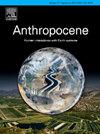Ancient mining pollution in early to middle Holocene lake sediments from the Lake Superior region, USA
Abstract
Determining the timing and transport mechanisms (i.e. fluvial and/or atmospheric) of pollution associated with ancient copper mining on Isle Royale in Lake Superior (United States) is important for understanding the current and future trajectory of ecosystems affected by human activity. This study reports metal concentrations in sediment from two small, closed-basin lakes located on Isle Royale (Lily Lake and Pond 2) as a measure of the extent of heavy metal emissions from Indigenous, precontact mining and annealing activities associated with one of the world’s oldest metal working industries. Lily Lake and Pond 2 are both located near known mines, but neither lake contains mines in its catchment and thus could not have received pollution via fluvial transport. Elevated concentrations of lead in sediments dating to ∼6000 years ago at both lakes provide evidence of atmospheric transport of pollution associated with mining emissions. The age of ∼6000 years before present is consistent with the timing of elevated lead concentrations in sediment from McCargoe Cove on the northern shore of Isle Royale. Collectively, the data indicate that the peak in Archaic Period mining occurred on southwestern Isle Royale ∼6000 years ago and was preceded by periods that varied in intensity and location across the area. The discovery of pollution signals in lake sediments from the Lake Superior region provides clues as to the timing, spatial patterns, and magnitude of one of the world’s earliest large-scale metal mining efforts. These findings provide a basis for determining the transport mechanisms of ancient mining pollution and are a step toward assessing the full environmental impact of mining and metal working efforts by early human civilizations.

 求助内容:
求助内容: 应助结果提醒方式:
应助结果提醒方式:


